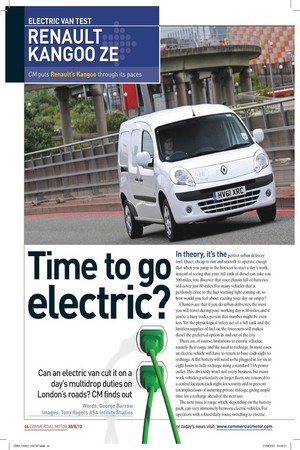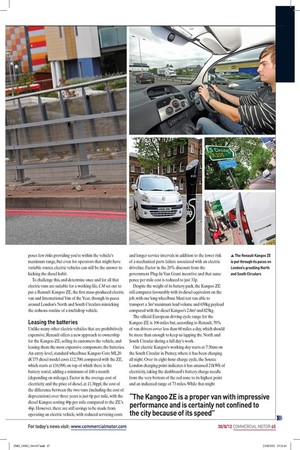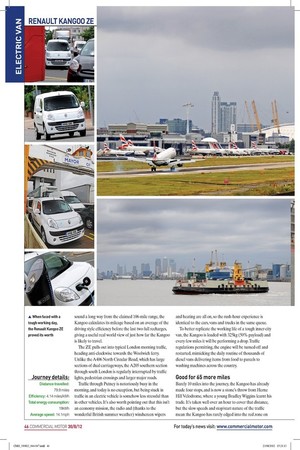Time to go
Page 33

Page 34

Page 35

Page 36

If you've noticed an error in this article please click here to report it so we can fix it.
electric?
Can an electric van cut it on a day’s multidrop duties on London’s roads? CM finds out
Words: George Barrow Images: Tony Rogers ASA Infinity Studios In theory, it’s the perfect urban delivery tool. Quiet, cheap to run and smooth to operate, except that when you jump in the hot seat to start a day’s work, instead of seeing that your full tank of diesel can take you 500 miles, you discover that your chassis full of batteries will cover just 80 miles. For many vehicles that is perilously close to the fuel warning light coming on, so how would you feel about starting your day on empty?
Chances are that if you do urban deliveries, the most you will travel during your working day is 80 miles, and if you’re a busy trades person that number might be even less. Yet the physiological safety net of a full tank and the limitless supplies of fuel on the forecourts still makes diesel the preferred option in and out of the city.
There are, of course, limitations to electric vehicles, namely their range and the need to recharge. In most cases an electric vehicle will have to return to base each night to recharge. A flat battery will need to be plugged in for six to eight hours to fully recharge using a standard 13A power outlet. This obviously won’t suit every business, but many work vehicles, particularly on larger fleets, are returned to a central location each night for security and to prevent tax implications of incurring private mileage, giving ample time for a recharge ahead of the next use.
The next issue is range which, depending on the battery pack, can vary immensely between electric vehicles. For operators with a fixed daily route, switching to electric poses few risks providing you’re within the vehicle’s maximum range, but even for operators that might have variable routes, electric vehicles can still be the answer to kicking the diesel habit.
To challenge this, and determine once and for all that electric vans are suitable for a working life, CM set out to put a Renault Kangoo ZE, the first mass-produced electric van and International Van of the Year, through its paces around London’s North and South Circulars mimicking the arduous routine of a multidrop vehicle.
Leasing the batteries
Unlike many other electric vehicles that are prohibitively expensive, Renault offers a new approach to ownership for the Kangoo ZE, selling its customers the vehicle, and leasing them the most expensive component, the batteries. An entry-level, standard wheelbase Kangoo Core ML20 dCi75 diesel model costs £12,700, compared with the ZE, which starts at £16,990, on top of which there is the battery rental, adding a minimum of £60 a month (depending on mileage). Factor in the average cost of electricity and the price of diesel, at £1.36ppl, the cost of the difference between the two vans (including the cost of depreciation) over three years is just 6p per mile, with the diesel Kangoo costing 40p per mile compared to the ZE’s 46p. However, there are still savings to be made from operating an electric vehicle, with reduced servicing costs and longer service intervals in addition to the lower risk of a mechanical parts failure associated with an electric driveline. Factor in the 20% discount from the government Plug-In Van Grant incentive and that same pence per mile cost is reduced to just 33p.
Despite the weight of its battery pack, the Kangoo ZE still compares favourably with its diesel equivalent on the job, with our long wheelbase Maxi test van able to transport a 3m3 maximum load volume and 650kg payload compared with the diesel Kangoo’s 2.8m3 and 825kg.
The official European driving cycle range for the Kangoo ZE is 106 miles but, according to Renault, 70% of van drivers cover less than 60 miles a day, which should be more than enough to keep us lapping the North and South Circular during a full day’s work.
Our electric Kangoo’s working day starts at 7:30am on the South Circular in Putney, where it has been charging all night. Over its eight-hour charge cycle, the Source London charging point indicates it has amassed 21kWh of electricity, taking the dashboard’s battery charge needle from the very bottom of the red zone to its highest point and an indicated range of 73 miles. While that might sound a long way from the claimed 106-mile range, the Kangoo calculates its mileage based on an average of the driving style efficiency before the last two full recharges, giving a useful real world view of just how far the Kangoo is likely to travel.
The ZE pulls out into typical London morning traffic, heading anti-clockwise towards the Woolwich ferry. Unlike the A406 North Circular Road, which has large sections of dual carriageways, the A205 southern section through south London is regularly interrupted by traffic lights, pedestrian crossings and larger major roads.
Traffic through Putney is notoriously busy in the morning, and today is no exception, but being stuck in traffic in an electric vehicle is somehow less stressful than in other vehicles. It’s also worth pointing out that this isn’t an economy mission, the radio and (thanks to the wonderful British summer weather) windscreen wipers and heating are all on, so the rush-hour experience is identical to the cars, vans and trucks in the same queue.
To better replicate the working life of a tough inner-city van, the Kangoo is loaded with 325kg (50% payload) and every few miles it will be performing a drop. Traffic regulations permitting, the engine will be turned off and restarted, mimicking the daily routine of thousands of diesel vans delivering items from food to parcels to washing machines across the country.
Good for 65 more miles
Barely 10 miles into the journey, the Kangoo has already made four stops, and is now a stone’s throw from Herne Hill Velodrome, where a young Bradley Wiggins learnt his trade. It’s taken well over an hour to cover that distance, but the slow speeds and stop/start nature of the traffic mean the Kangoo has rarely edged into the red zone on the dashboard’s econometer display and is still good for 65 more miles.
After passing through Catford, Eltham and Woolwich, the Kangoo arrives at the Thames and joins the surprisingly modest queue for the ferry crossing. The Kangoo has so far used just 4kWh of electricity to cover 20 miles at an average of 11mph. The range also appears to be tracking on target with 52 miles remaining. Up next is City airport, Barking, Redbridge and Walthamstow, taking in a number of 50mph dual carriageways.
In the early days, many electric vehicles were limited to speeds of about 30mph. Fortunately, the Kangoo ZE is a proper van with impressive performance and is certainly not confined to the city because of its speed. The continuous drive makes progress smooth, and the instantaneous 226Nm of torque ensures the Kangoo ZE is a match for any diesel equivalent, comfortably conquering the ups and downs of the many overpasses without the need to stray into the battery-sapping red zone. As the ZE reaches the bottom of the M1 at Brent Cross, the onboard computer, which constantly keeps the driver updated with range, remaining battery capacity, and average and instantaneous energy consumption indicates that the higher speeds of the North Circular have increased our energy consumption from an average of 4.14 miles/kWh to 3.96 miles/kWh. The range indicator still says the ZE is on course to cover more than 70 miles, while encouragingly we have used just 9kWh of energy over the past 40 miles.
The Ace Café, Wembley and the A40 junction at Hanger Lane all sail by and before long the Kangoo is crossing Kew Bridge and back on the A205 in Putney. Once again the Kangoo is tracking close to its expected range and with 50 miles covered there are still 23 miles in reserve. The average is back up to 4.08 miles/kWH and so, too, is the average speed at 15.9mph. One complete lap of London down, and 12kWh have been consumed, leaving 8kWh of energy before the Kangoo should be retired. Factoring in the small amount of energy recouped by the regenerative braking system, that should also leave enough in reserve to find a charging point.
Five hours into our multidrop shift and the traffic is considerably lighter. The Renault has dealt with the changing traffic conditions admirably, delivering a comfortable and enjoyable ride along with a quick, yet serene, performance from the 60hp driveline. The slightly higher speeds have also marginally improved our predicted range, and for the first time the ZE looks on course to surpass its estimated starting range: with 60.2 miles under its belt, there is an indicated 17-mile range left.
Seven solid hours of work
As three miles appears on the range display, the Kangoo’s indicator finally turns to three dashed lines and a repetitive and ominous warning beep begins. Total consumption has reached 19kWh, and although anxiety is creeping in, the Kangoo has already notched up seven solid hours of work throughout the day. The continual stop-start traffic, and the routine of our counterfeit delivery schedule has done little to affect its working day, so with 79.9 miles on the journey trip computer and 19kWh of energy consumed, the Renault’s odyssey is finally over.
There are several miles left in the lithium-ion batteries, but in the real world you’re unlikely to want to push your luck at the risk of being stranded. Depending on your business, 40 drops for the day might also be unrealistic, but nevertheless, the ZE experiment has shown that when faced with a tough working day electric vans are now more than capable of performing the job of a diesel. With financial benefits of no road tax and reduced maintenance, a smoother journey for the driver, and zero tailpipe emissions, the Kangoo ZE can work for any business. ■








































